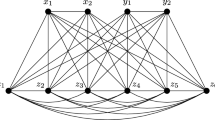Abstract
In this paper, we prove that an m-connected graph G on n vertices has a spanning tree with at most k leaves (for k ≥ 2 and m ≥ 1) if every independent set of G with cardinality m + k contains at least one pair of vertices with degree sum at least n − k + 1. This is a common generalization of results due to Broersma and Tuinstra and to Win.
Similar content being viewed by others
References
Bondy, J.A.: Basic Graph Theory: Paths and Circuits, in: Handbook of Combinatorics, Vol. I, Graham, R., Grőtshel, M., and Lovász, L. (eds), Elsevier, Amsterdam 1995, pp. 5–110
Broersma, H., Tuinstra, H.: Independence trees and Hamilton cycles. J. Graph Theory 29, 227–237 (1998)
Chvátal, V., Erdős, P.: A note on hamiltonian circuits, Discrete Math. 2, 111–113 (1972)
Ore, O.: Note on Hamilton circuits, Am. Math. Monthly 67, 55 (1960)
Win, S.: On a conjecture of Las Vergnas concerning certain spanning trees in graphs, Resultate Math. 2, 215–224 (1979)
Author information
Authors and Affiliations
Corresponding author
Rights and permissions
About this article
Cite this article
Tsugaki, M., Yamashita, T. Spanning Trees with Few Leaves. Graphs and Combinatorics 23, 585–598 (2007). https://doi.org/10.1007/s00373-007-0751-y
Received:
Accepted:
Issue Date:
DOI: https://doi.org/10.1007/s00373-007-0751-y




